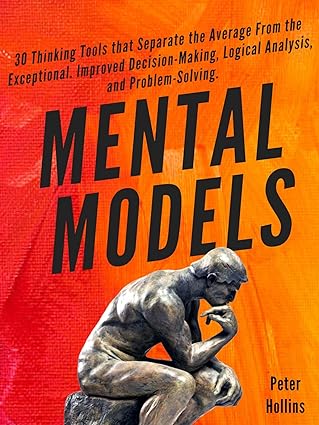In a world overflowing with information and complex choices, the ability to think clearly and effectively is more critical than ever. Mental models, cognitive frameworks that help us understand the world and make informed decisions, are essential tools for navigating this complexity. Peter Hollins' book, "Mental Models: 30 Thinking Tools that Separate the Average From the Exceptional," provides a valuable introduction to this powerful concept. This white paper expands on Hollins' work, exploring the importance of mental models, delving into specific examples, and discussing how to apply them for improved decision-making, logical analysis, and problem-solving.
Mental Models: Thinking Tools for Exceptional Decision-Making
Introduction:
In a world overflowing with information and complex choices, the ability to think clearly and effectively is more critical than ever. Mental models, cognitive frameworks that help us understand the world and make informed decisions, are essential tools for navigating this complexity. Peter Hollins' book, "Mental Models: 30 Thinking Tools that Separate the Average From the Exceptional," provides a valuable introduction to this powerful concept. This white paper expands on Hollins' work, exploring the importance of mental models, delving into specific examples, and discussing how to apply them for improved decision-making, logical analysis, and problem-solving.
What are Mental Models?
Mental models are representations of how something works. They are simplified frameworks that help us understand complex systems, make predictions, and solve problems. These models can be drawn from various disciplines, including physics, biology, psychology, economics, and engineering. By utilizing a diverse set of mental models, we can approach situations from multiple perspectives, leading to more nuanced and effective solutions.
Why are Mental Models Important?
- Improved Decision-Making: Mental models provide a structured approach to decision-making, helping us to consider various factors and potential outcomes.
- Enhanced Problem-Solving: By offering different perspectives, mental models enable us to identify the root causes of problems and develop creative solutions.
- Increased Learning and Understanding: Mental models facilitate deeper understanding by providing frameworks for organizing and interpreting information.
- Better Communication: Shared mental models improve communication by ensuring that individuals have a common understanding of the situation.
- Reduced Bias: By encouraging us to consider alternative viewpoints, mental models can help mitigate cognitive biases that can lead to poor judgment.
Key Mental Models:
This section explores some of the key mental models discussed by Hollins and others:
- First Principles Thinking: This involves breaking down complex problems into their fundamental elements and reasoning from basic truths. (Reference: Elon Musk interviews)
- Second-Order Thinking: This encourages us to consider the consequences of the consequences, going beyond the immediate effects of a decision. (Reference: Howard Marks, "The Most Important Thing")
- Inversion: This involves looking at a problem backward, considering what we want to avoid rather than what we want to achieve. (Reference: Charlie Munger speeches)
- Occam's Razor: This principle suggests that the simplest explanation is usually the best. (Reference: William of Ockham, 14th-century philosopher)
- Hanlon's Razor: This states, "Never attribute to malice that which is adequately explained by stupidity." (Reference: Robert J. Hanlon)
- Confirmation Bias: This refers to our tendency to seek out information that confirms our existing beliefs and ignore contradictory evidence. (Reference: Daniel Kahneman, "Thinking, Fast and Slow")
- Availability Bias: This is the tendency to overestimate the likelihood of events that are readily available in our memory. (Reference: Amos Tversky and Daniel Kahneman)
- Loss Aversion: This describes our tendency to feel the pain of a loss more strongly than the pleasure of an equivalent gain. (Reference: Daniel Kahneman and Amos Tversky)
- The Map is Not the Territory: This reminds us that our mental models are simplifications of reality and should not be confused with reality itself. (Reference: Alfred Korzybski, "Science and Sanity")
- Circle of Competence: This encourages us to focus on areas where we have expertise and avoid venturing into areas where we lack understanding. (Reference: Warren Buffett)
(Note: This is not an exhaustive list, and many other valuable mental models exist. Hollins' book provides a more comprehensive overview.)
Applying Mental Models:
To effectively utilize mental models, consider the following steps:
- Learn and Understand: Familiarize yourself with a variety of mental models from different disciplines.
- Identify Relevant Models: Determine which models are most applicable to the situation at hand.
- Apply and Analyze: Use the chosen models to analyze the situation, consider different perspectives, and generate potential solutions.
- Reflect and Refine: Evaluate the outcomes of your decisions and refine your mental models based on your experiences.
Challenges and Limitations:
- Over-reliance: It is important to remember that mental models are simplifications and may not always accurately reflect reality.
- Bias in Model Selection: Our own biases can influence which models we choose to apply.
- Complexity: Applying multiple models can be challenging and require significant cognitive effort.
Conclusion:
Mental models are powerful tools that can significantly enhance our thinking abilities. By learning and applying a diverse set of models, we can improve our decision-making, problem-solving, and overall understanding of the world. While challenges and limitations exist, the benefits of utilizing mental models far outweigh the drawbacks. As Peter Hollins suggests, mastering these thinking tools can indeed separate the average from the exceptional.
Further Reading and References:
- Hollins, P. (Year of Publication). Mental Models: 30 Thinking Tools that Separate the Average From the Exceptional.
- Munger, C. T. (Various speeches and writings).
- Kahneman, D. (2011). Thinking, Fast and Slow. Farrar, Straus and Giroux.
- Marks, H. (2011). The Most Important Thing: Uncommon Sense for the Thoughtful Investor. Columbia University Press.
This white paper provides a starting point for understanding and applying mental models. Continued learning and practice are essential for developing mastery in this area.
